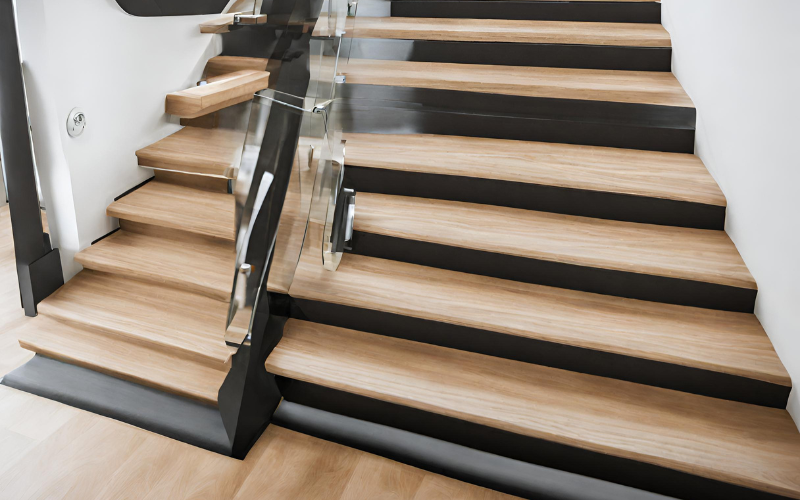
Stair nosing, often perceived as a mere decorative feature or a minor detail, holds significant importance in the aesthetic and functional aspects of Australian staircases. Whether you’re a homeowner planning a staircase renovation or a builder working on a commercial project, understanding stair nosing is crucial. This blog aims to cover all the essential aspects of stair nosing in Australia with considering all safety and building code requirements. It ensures compliance with regulations and contributes to the overall safety and integrity of the staircase design.
Public staircases in Australia pose a particular risk due to their high foot traffic and usage. Additionally, falls in residential spaces have steadily increased each year. It highlights the importance of adhering to stair safety standards for homeowners and businesses. Property owners, construction professionals, and facility managers are responsible for prioritising compliance with safety regulations when installing stair nosing.
What Is a Stair Nosing and Its Purpose?
Stair nosing is a decorative and protective feature when installed along the front edge of stairs.
- Aesthetics:Stair nosing is available in diverse materials and designs and enhances the overall appearance of the staircase, complementing the interior decor of residential and commercial spaces.
- Durability:Given the heavy foot traffic that stairs endure, their edges are prone to wear and tear. Stair nosing adds a layer of protection to these vulnerable areas, thereby extending the staircase’s lifespan.
Types of Stair Nosing
You’ll find a diverse selection of stair-nosing products tailored to suit individual needs and tastes. The most popular ones include:
Hybrid
Hybrid flooring offers an innovative, cost-effective, and durable solution for flooring needs. The capability to manufacture hybrid stair nosings from diverse products makes hybrid flooring an even more sophisticated and efficient choice. It facilitates clients to seamlessly transition from the floor to the top of their stairs.
Laminate
Laminate floors have remarkable durability and resistance to wear and tear. Some laminate products are up to five times more scratch-resistant compared to hardwood floors. The conversion service transforms high-quality laminate floorboards into stair-nosing solutions with a superior finish, ensuring a flawless end-to-end flooring solution and consistent appearance from floor to staircase.
Vinyl Plank
Vinyl plank flooring presents a practical and cost-effective option for homeowners, offering various choices to suit different interior styles. The vinyl plank stair nosing solutions enable customers to perfectly match their vinyl plank floor with a quality finish at a modest budget.
Engineered
Engineered timber floors can enhance the aesthetic of any home with their stunning appearance. Augment the beauty of engineered floors with product-matched stair nosing. The custom manufacturing process accommodates most hardwood-engineered flooring products, seamlessly transforming them into a complete stair-nosing system.
Australian Building Codes & Regulations
Ensuring compliance and safety during stair-nosing installation in Australia involves strict adherence to building codes and regulations. The Building Code of Australia (BCA) is a crucial resource containing guidelines for stair design and construction, including specifications for stair nosing usage. Here are several essential considerations to keep in mind:
- Sizing:As per the BCA, stair nosing must adhere to the minimum and maximum dimensions to ensure adequate grip without a tripping hazard.
- Smooth Transition:Stair nosing should maintain a seamless, continuous surface on the stairs without any abrupt changes that could lead to tripping hazards.
- Slip Resistance:Stair-nosing materials must meet specific slip resistance criteria outlined by the BCA to mitigate the risk of accidents.
Is Stair Nosing Obligatory?
Stair nosing is a requisite. As per AS1428.1, the Australian Standard for Designing Access and Mobility Part 1, stair nosing must be installed in all new construction projects. This standard aims to improve accessibility for individuals with disabilities, covering diverse aspects of building design and setting minimum criteria based on layout and usage.
Since stair nosing is a vital component of a staircase’s surface, it’s crucial to adhere to slip resistance regulations when choosing materials and installing them.
Installation & Maintenance
The proper installation of stair nosing is fundamental to its functionality. It must be securely attached to the stairs using appropriate adhesives. Regular maintenance is required to preserve the nosing’s condition. It involves cleaning, inspecting for wear and tear, and replacing damaged nosings whenever needed.





